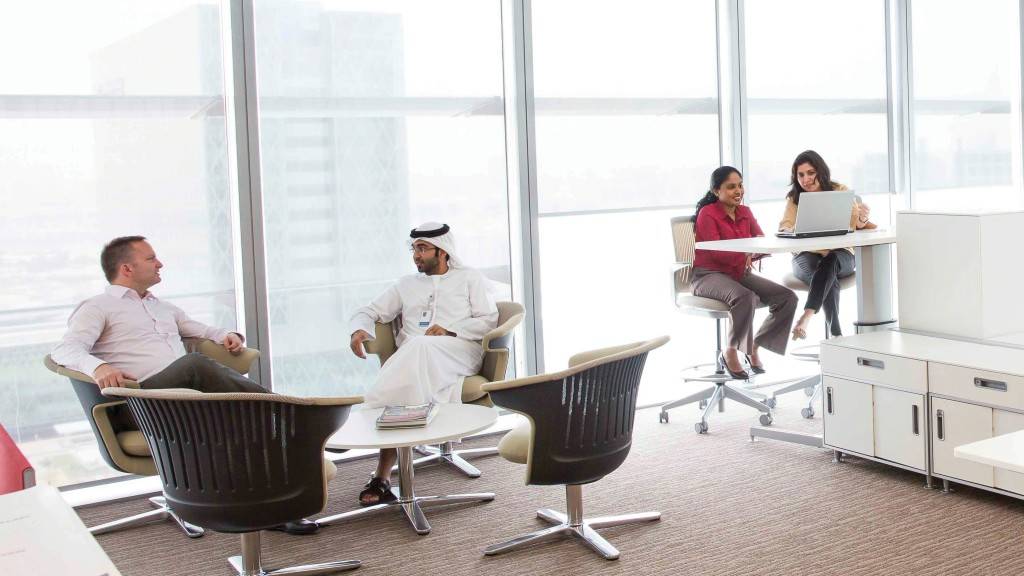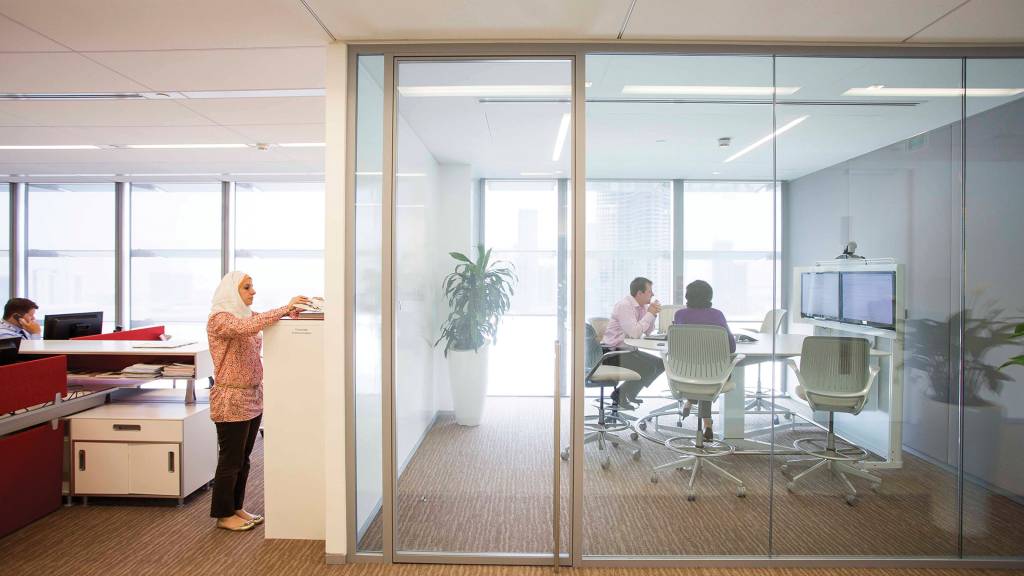TAQA Redesign: Collaboration meets Privacy
If one word can sum up the strategic intent behind the creation of flagship headquarters for TAQA, the global energy company, it is Majlis—which in Arabic signifies a place where people gather and are welcomed by their hosts.
If one word can sum up the strategic intent behind the creation of flagship headquarters for TAQA, the global energy company, it is Majlis—which in Arabic signifies a place where people gather and are welcomed by their hosts.
When TAQA decided to establish a new corporate headquarters facility in Abu Dhabi, company leaders knew that it needed to be a place for meeting, greeting and interacting—where people could come together, work together and share in the benefits of an inspiring environment. At the same time, especially because many employees were initially wary of losing the convention of individual workspaces, they knew that individual needs for privacy could not be overlooked in the design of the new space.
Established in 2005, TAQA has grown into one of the most dynamic energy companies in the world. With operations spanning the energy industry and interests in 11 countries, its speed of growth has been laudatory.

This rapid rise meant, however, that in Abu Dhabi employees were distributed across several sites, increasingly causing logistical issues. Even more important, senior management realized that bringing employees in their headquarters city together could better capitalize on their collective brainpower.
“Although we were a young company, we were sitting on $32 billion of assets across the world. And yet our teams in Abu Dhabi were still working in silos… We had to remove some of the barriers,” says Ifran Nadeem, TAQA executive vice president.
“We wanted to create a space that would reflect the diversity of our business and enable people to connect more easily. Innovation and new technologies are, of course, extremely important. But what matters most of all for a business is the quality of its people and the strength of the relationships between those people.”
In 2012 TAQA secured the 23rd, 24th and 25th floors of a high-rise on Abu Dhabi’s Al Maryah Island. To make sure they understood mindsets and readiness for change, TAQA’s leadership team started the project by consulting extensively with employees. It quickly became clear that the issue of privacy was an important design consideration. Many employees said that a loss of privacy—be it space or the ability to work comfortably on confidential documents and sensitive client issues—would not be welcomed.
“Like many businesses in the Arabic world, our people had been used to a working environment where there were many private offices and a working environment that did little to encourage collaboration,” says Khaled Hag, business development manager.
At first, it looked as though the project could become mired in compromises that would diminish the scope of what TAQA hoped to achieve.
“There was a lot of resistance,” explains Ali Khouri, TAQA director of strategic co-ordination, who led the project team implementing the move to the new headquarters. “People in more senior positions had expected their own private office to reflect their position, but also they felt they could only work on confidential matters in such an environment.”

Moreover, privacy concerns weren’t limited to leaders. As the project team listened to employees, they realized there needed to be a balance for all employees—spaces that satisfied individual privacy needs and also spaces that supported collaboration.
TAQA began working with architects Pringle Brandon Perkins & Will and contractor EC Harris on the design of their new 5,543 square-meters headquarters. To gain insights into options, planners visited Steelcase facilities in Rosenheim, Germany, and Grand Rapids, Michigan.
“We were presented with solutions, rather than items of furniture, and that made a huge difference to us,” says Khouri. “It led us to being much more bold than we originally envisaged.”
“We wanted to create a space that would reflect the diversity of our business and enable people to connect more easily.”
Ifran Nadeem
For example, he says, TAQA employees were concerned about the confidentiality of documents they printed in a shared environment. Showing them how a smart printing function works reassured that, although printers would be for communal use, they could still protect private documents.
It was also important for employees to know there would be spaces where they could make private calls and numerous meeting rooms in the client area for interaction with external visitors without disrupting activities in the office.
As TAQA’s 250+ Abu Dhabi-based employees began moving into their new headquarters, trepidations began to evaporate.
“Some people took longer than others, but in general it was a very fast transformation. And some of the people who were most concerned about the lack of privacy were the most enthusiastic about our new home,” says Khouri. “People grasped what it was all about.”
The collaborative applications within the space proved an immediate success, and media:scape® settings were an obvious favorite. According to Khouri, media:scape “showed, probably more than anything, collaborative and effective working at its best.” Since the move, a number of senior executives have asked to give up their private individual offices to work in the collaborative spaces.
The floor plan presents a seamless blend of open workstations and shared environments for privacy. Brightly colored furniture communicates informality and creativity, and glass partitions are decorated with graphics representing flowing waves of energy. Floor-to-ceiling windows offer expansive views of the Gulf and old Abu Dhabi, enhancing what is a dynamic yet serene office environment.
Client meetings take place on the 25th floor, which includes a boardroom, numerous meeting rooms, an auditorium and, of course, a Majlis, the company’s place of welcome.
TAQA prides itself on the values that have propelled it on the global stage: pursuing excellence, safe and sustainable, stronger together, courageous and creative, and trusting and trusted. Their new headquarters reflect these values, and also empower employees to take them to the next level.
“People work in different ways, and we needed to give them different options,” says Hag. “Those who had concerns about privacy found those fears were allayed as they became used to the new environment… I do not think there is anyone who would turn the clock back now to the way things were.”
As with any culture change, it was extremely important that TAQA leadership was behind the project. With the support of leadership at the top, the project team successfully “grabbed the project by the horns,” says Hag.
“Probably, the most gratifying aspect has been the response of our employees,” he emphasizes. “An inspiring working environment has brought out the best in them, and they were re-invigorated by the change.”


